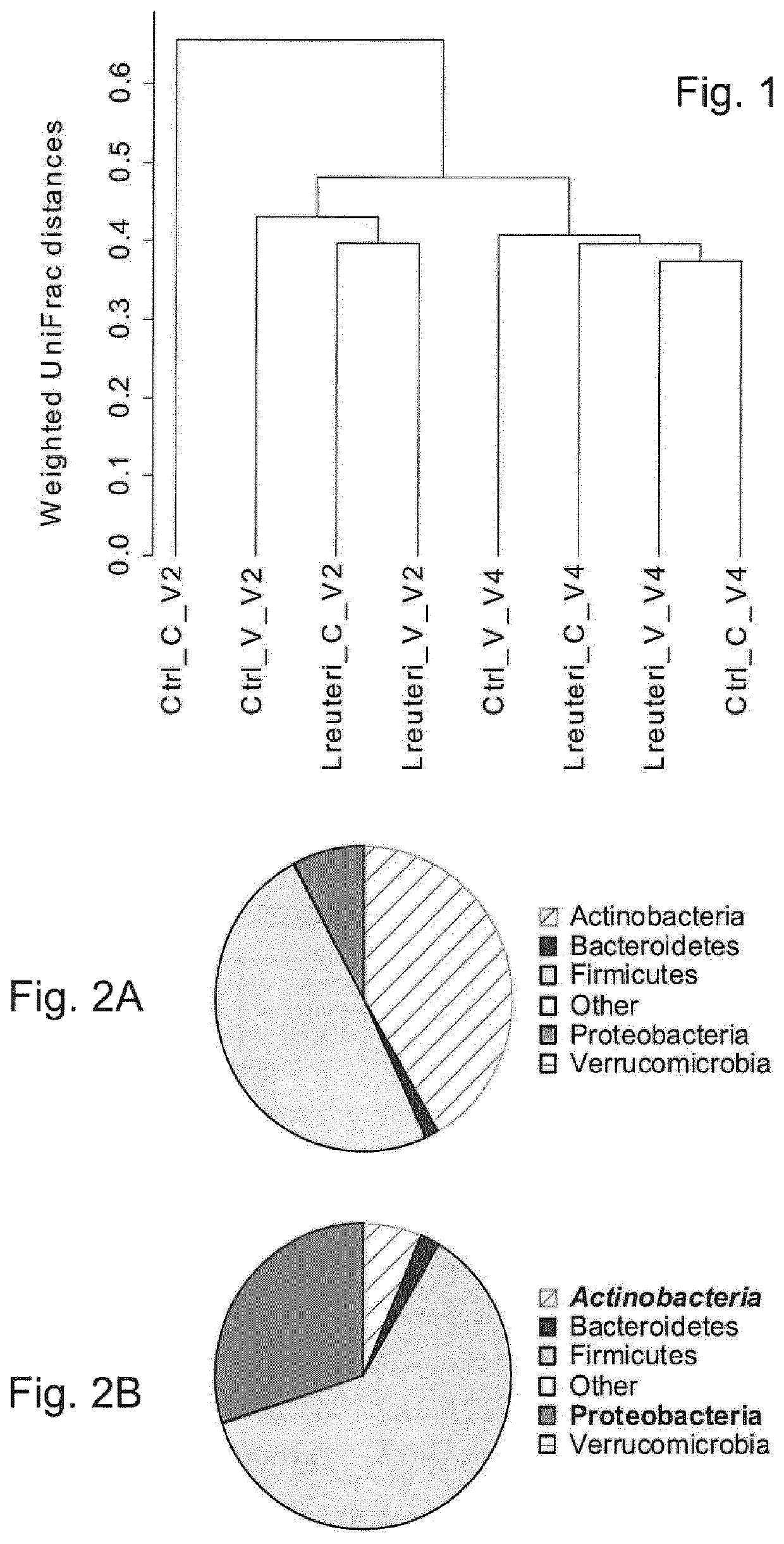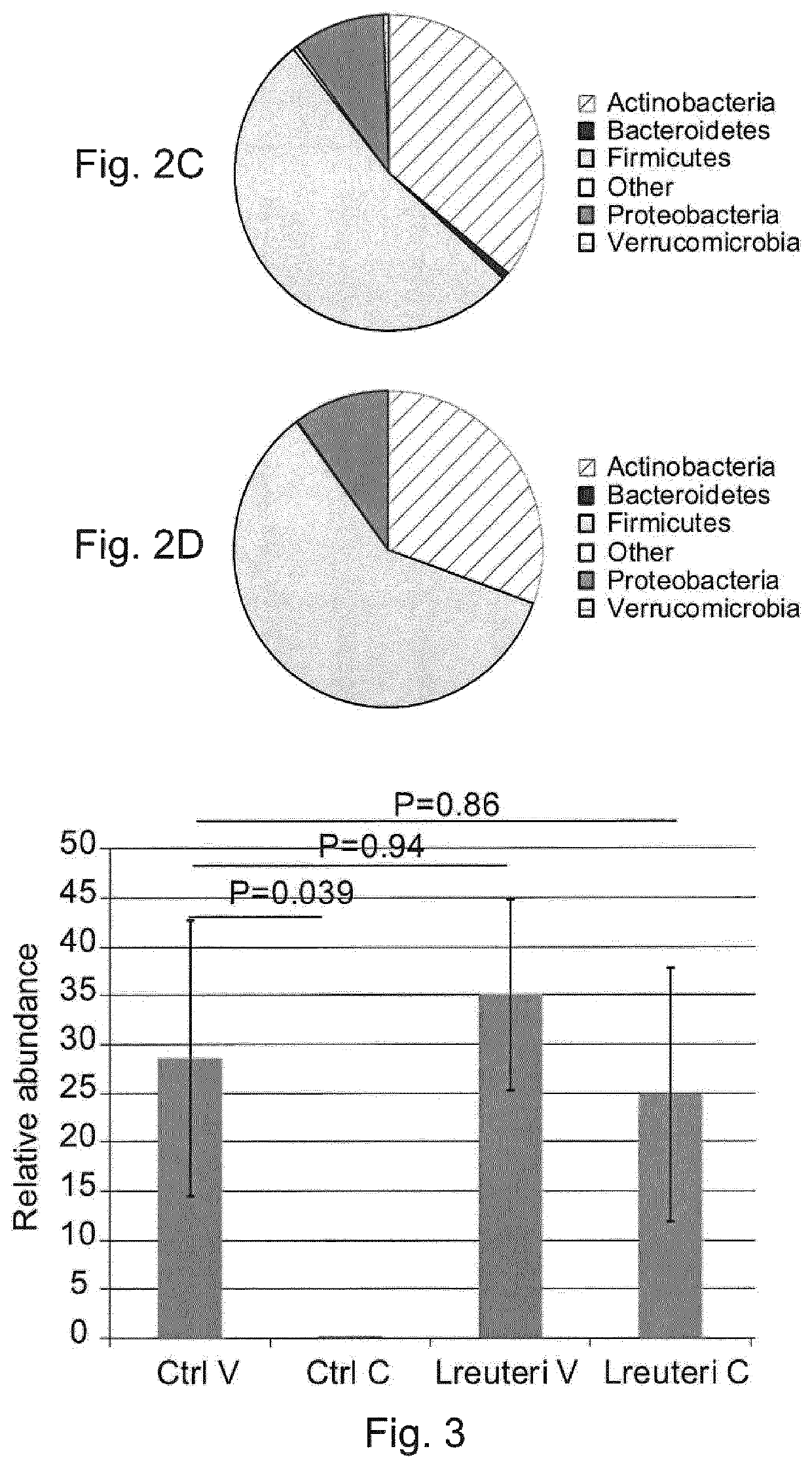Use of L. reuteri for recovery of microbiota dysbiosis in early life
a technology of i>l. reuteri/i> and early life, which is applied in the direction of drug composition, immunological disorders, metabolism disorders, etc., can solve the problems of increased risk of infection and other pathologies in infants, increased risk of microbiota dysbiosis, and increased risk of infant infection and other pathologies
- Summary
- Abstract
- Description
- Claims
- Application Information
AI Technical Summary
Benefits of technology
Problems solved by technology
Method used
Image
Examples
example 1
Study Set-Up
[0141]A single-center, prospective, randomized, controlled, double-blind clinical trial of two groups in parallel was carried out. Healthy, full-term babies, anticipated to be exclusively formula-fed were enrolled in the study. Infants were enrolled within the 48 hours following birth and were randomly assigned to one of 2 treatment groups:
1. Subjects receiving Starter Formula containing Lactobacillus reuteri (108 cfu of L. reuteri per day) from birth to 6 months (n=60).
2. Subjects receiving Starter Formula without Lactobacillus reuteri from birth to 6 months (n=60).
[0142]Stool samples were collected at 14 days and 4 months of infant age, refrigerated at 4° C. for a maximum of 10 hours after emission and kept frozen at −80° C. until microbiota analysis was carried out.
Fecal Microbiota Analysis
[0143]Twenty infants in each group were selected to study the fecal microbiota composition. The selection was performed randomly, but with two stratification criteria:...
example 2
[0147]An example of the composition of an infant formula for use according to the present invention is given below. This composition is given by way of illustration only. The protein source is a mixture of 60% MSWP28 and 40% casein.
[0148]
Nutrientper 100 kcalper litreEnergy (kcal)100670Protein (g)1.8312.3Fat (g)5.335.7Linoleic acid (g)0.795.3α-Linolenic acid (mg)101675Lactose (g)11.274.7Prebiotic (100% GOS) (g)0.644.3Minerals (g)0.372.5Na (mg)23150K (mg)89590Cl (mg)64430Ca (mg)62410P (mg)31210Mg (mg)750Mn (μg)850Se (μg)213Vitamin A (μg RE)105700Vitamin D (μg)1.510Vitamin E (mg TE)0.85.4Vitamin K1 (μg)854Vitamin C (mg)1067Vitamin B1 (mg)0.070.47Vitamin B2 (mg)0.151.0Niacin (mg)16.7Vitamin B6 (mg)0.0750.50Folic acid (μg)960Pantothenic acid (mg)0.453Vitamin B12 (μg)0.32Biotin (μg)2.215Choline (mg)1067Fe (mg)1.28I (μg)15100Cu (mg)0.060.4Zn (mg)0.755L. reuteri2 × 107 cfu / g of powderDSM 17938
PUM
| Property | Measurement | Unit |
|---|---|---|
| durable | aaaaa | aaaaa |
| microbiota composition | aaaaa | aaaaa |
| UniFrac distance | aaaaa | aaaaa |
Abstract
Description
Claims
Application Information
 Login to View More
Login to View More - R&D
- Intellectual Property
- Life Sciences
- Materials
- Tech Scout
- Unparalleled Data Quality
- Higher Quality Content
- 60% Fewer Hallucinations
Browse by: Latest US Patents, China's latest patents, Technical Efficacy Thesaurus, Application Domain, Technology Topic, Popular Technical Reports.
© 2025 PatSnap. All rights reserved.Legal|Privacy policy|Modern Slavery Act Transparency Statement|Sitemap|About US| Contact US: help@patsnap.com


